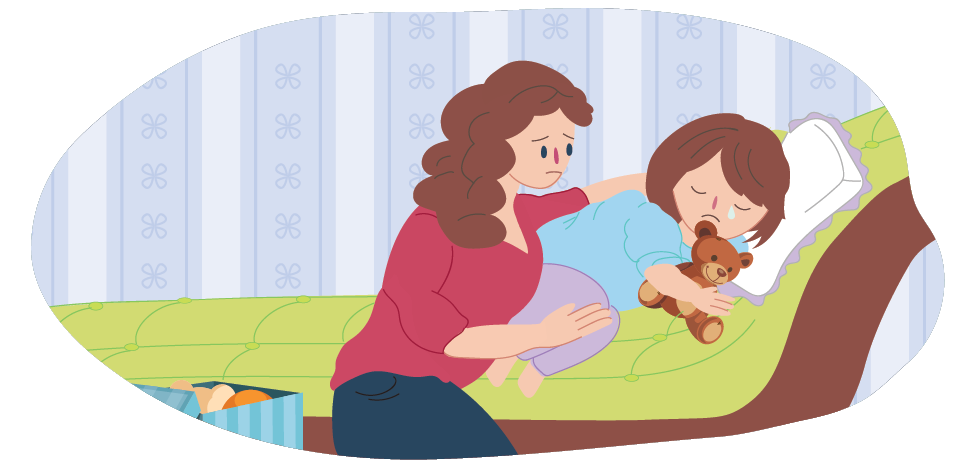Helping kids identify and express feelings
Learning to identify and express feelings in a positive way helps kids develop the skills they need to manage them effectively. Here are some tips on how to encourage your child to express their feelings.

Understanding feelings in kids
Kids deal with many of the same feelings adults do
Kids experience complex feelings just like adults. They get frustrated, excited, nervous, sad, jealous, frightened, worried, angry and embarrassed.
However young kids usually don’t have the vocabulary to talk about how they are feeling. Instead they communicate their feelings in other ways.
Kids can express their feelings through facial expressions, through their body, their behaviour and play. Sometimes they may act out their feelings in physical, inappropriate or problematic ways.
From the moment kids are born, they start learning the emotional skills they need to identify, express and manage their feelings. They learn how to do this through their social interactions and relationships with important people in their lives such as parents, grandparents and carers.
Being a parent means you’ve got a really important role to play in helping kids understand their feelings and behaviours. Kids need to be shown how to manage their feelings in positive and constructive ways.
When kids learn to manage their emotions in childhood it leads to positive attitudes and behaviours later in life
Kids who learn healthy ways to express and cope with their feelings are more likely to:
What you can do to help your child develop their emotional skills
Here are some of the ways you can help your child learn about and express their feelings:
- Tune into cues - Sometimes feelings can be hard to identify. Tune into your child’s feelings by looking at their body language, listening to what they’re saying and observing their behaviour. Figuring out what they feel and why means you can help them identify, express and manage those feelings better.
- Behind every behaviour is a feeling - Try to understand the meaning and feeling behind your child’s behaviour. You can help your child find other ways to express that feeling once you know what is driving the behaviour.
- Name the feeling - Help your child name their feelings by giving them a label. Naming feelings is the first step in helping kids learn to identify them. It allows your child to develop an emotional vocabulary so they can talk about their feelings.
- Identify feelings in others – Provide lots of opportunities to identify feelings in others. You might ask your child to reflect on what someone else may be feeling. Cartoons or picture books are a great way discuss feelings and helps kids learn how to recognise other people’s feelings through facial expressions.
- Be a role model - Kids learn about feelings and how to express them appropriately by watching others. Show your child how you’re feeling about different situations and how you deal with those feelings.
- Encourage with praise - Praise your child when they talk about their feelings or express them in an appropriate way. Not only does it show that feelings are normal and it’s ok to talk about them, it reinforces the behaviour so they are likely to repeat it.
- Listen to your child’s feelings - Stay present and resist the urge to make your child’s bad feelings go away. Support your child to identify and express their feelings so they are heard. When feelings are minimised or dismissed, they will often be expressed in unhealthy ways.
Sometimes kids don’t have the words to express how they feel and may act out these feelings in ways that are problematic
Your child might hit or throw toys when angry or frustrated. They might have a hard time settling down after an exciting day. Use this as a learning opportunity to teach your child to express their feeling in a positive way. Teach your child to act on feelings by:
Taking some deep breaths
Asking for help or support
Walking away and taking time out
Finding a different way to do things
Taking time to relax before trying again
Trying to solve the problem with words
Saying what they feel instead of acting it out
Talking with a grown-up about what is happening
Spending time with a loved one or asking for a hug or cuddle
Describing what they are feeling or reactions in their body
You play an important role in your child’s emotional development
Helping your child identify their feelings is the first step in helping them manage them.
Kids who are able to identify, understand, express and manage a wide range of feelings experience long term benefits to their mental health and wellbeing.
If your child needs some extra support talking about and expressing their feelings, we’re here to help! Encourage them to talk to a Kids Helpline counsellor today.
They can call, start a WebChat or send us an email.
If you are looking for more digital services and resources, check out Head to Health.
Check these out too:
Communication tips
Young people often tell Kids Helpline they find it difficult to communicate ...
READ MEAnxiety in kids and teens
Parenting a child with anxiety is tough, but you don't have to ...
READ MEHow Kids Helpline can help your child
Curious about what Kids Helpline does and how it can help? We’...
READ MEHow Parentline can help you
Parenting can be a tough job but also really rewarding. Talking to ...
READ METalking helps! We’re here for your kids.
No problem is too big or too small.
We're here 24 hours a day, 7 days a week






